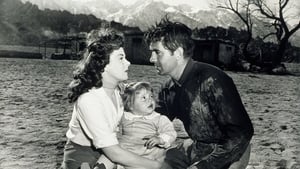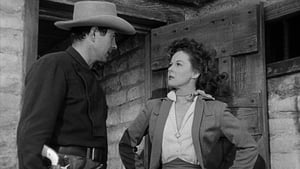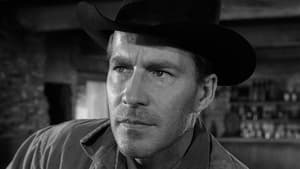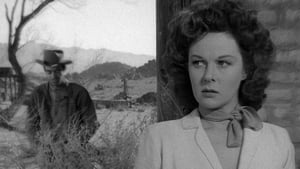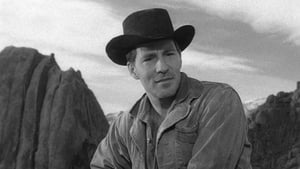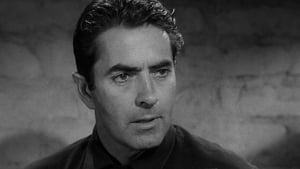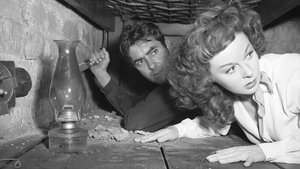Contact: info@alwanfilm.com
Video Sources 0 Views

Synopsis
Rawhide 1951 Colorized Review: A Tense Western Thriller in Technicolor

Introduction
Released in 1951, Rawhide is a gripping Western thriller directed by Henry Hathaway and starring Tyrone Power and Susan Hayward. Set against the rugged backdrop of the American frontier, Rawhide presents a suspenseful tale of survival, tension, and unexpected heroism. This film, produced during the height of Hollywood’s Western craze, combines the genre’s classic elements of danger and lawlessness with a claustrophobic sense of isolation and vulnerability, making it stand out from other Westerns of its era.
While Rawhide was originally released in black and white, the film was later colorized, offering a new dimension to its already intense visuals. In this review, we will explore the impact of the colorization process on Rawhide and discuss how it enhances or alters the film’s viewing experience. Additionally, we’ll take a closer look at the film’s storyline, its memorable performances, and the lasting influence it has had on the Western genre.
Check The Full Colorized Movies List
Check Our Colorized Movies Trailer Channel
Understanding Rawhide 1951 Colorized: Director, Cast, and Genre
Henry Hathaway’s Vision for Rawhide
Henry Hathaway, a director known for his versatility and expertise in various genres, crafted Rawhide as a tense, character-driven Western. Unlike many traditional Westerns that rely heavily on action-packed shootouts and sweeping landscapes, Hathaway’s Rawhide takes a more psychological approach, focusing on the internal struggles of its characters and the harrowing circumstances they face. The film’s confined setting—a remote stagecoach relay station—adds to its sense of suspense and tension, which was Hathaway’s deliberate attempt to create a more intimate and nerve-wracking Western experience.
Hathaway’s direction is marked by his ability to build tension gradually, allowing the audience to feel the claustrophobic atmosphere of the station and the growing sense of danger as the story unfolds. His approach to Rawhide is what sets the film apart from more conventional Westerns, making it a thrilling and unique entry in the genre.
The Cast’s Iconic Performances
Rawhide features strong performances from its lead actors, Tyrone Power and Susan Hayward, who bring depth and complexity to their roles. Power plays Tom Owens, a mild-mannered stagecoach station worker who finds himself thrust into a life-or-death situation when a group of outlaws takes over the station. Power, typically known for playing more heroic characters, delivers a more subdued and vulnerable performance in Rawhide, which makes his eventual transformation into a reluctant hero all the more compelling.
Susan Hayward, on the other hand, portrays Vinnie Holt, a tough and determined woman traveling with her young niece. Hayward’s performance is fierce and resilient, as her character refuses to be reduced to a damsel in distress. Instead, Vinnie becomes a pivotal figure in the story, standing her ground against the outlaws and forming an unlikely alliance with Tom. The chemistry between Power and Hayward is palpable, and their evolving relationship adds emotional depth to the film.
The supporting cast, led by Hugh Marlowe as the menacing outlaw Rafe Zimmerman, is equally strong. Marlowe’s portrayal of Zimmerman as a cold, calculating criminal heightens the tension and makes for a formidable antagonist.
Exploring the Genre
Rawhide is a Western, but it incorporates elements of the thriller and survival genres, which gives it a distinct edge. While the film features many of the familiar tropes of Westerns—such as outlaws, gunslingers, and remote settings—it departs from traditional narratives by focusing more on the psychological tension between the characters and their desperate situation. This blend of genres makes Rawhide a standout Western that goes beyond simple action and adventure, offering a deeper exploration of human behavior under pressure.
Exploring the World of Rawhide 1951 Colorized: Plot and Characters
Detailed Synopsis
The plot of Rawhide unfolds at a remote stagecoach relay station in the American West. Tom Owens (Tyrone Power) is a station worker who, despite his father’s wishes, avoids getting involved in the dangerous world of stagecoach travel. His life is upended when a stagecoach arrives carrying Vinnie Holt (Susan Hayward) and her young niece, Callie. Although Tom initially appears indifferent, he soon finds himself drawn into a deadly situation when the stagecoach is delayed due to the arrival of four outlaws.
Led by the ruthless Rafe Zimmerman (Hugh Marlowe), the gang plans to rob a stagecoach carrying a large shipment of gold. They take over the station, holding Tom, Vinnie, and Callie hostage while they wait for the gold to arrive. As tensions rise, Tom and Vinnie must work together to survive the night and outwit their captors. The film’s claustrophobic setting adds to the tension, as the characters are trapped in the isolated station with no hope of escape.
Key moments in the plot include Tom’s gradual transformation from a reluctant bystander to an active participant in the fight for survival, as well as Vinnie’s unwavering determination to protect her niece at all costs. The film builds to a suspenseful climax as the characters devise a daring plan to outsmart the outlaws and escape with their lives.
Complex Protagonists and Memorable Supporting Characters
Both Tom and Vinnie are complex, well-drawn characters whose evolution throughout the film drives the narrative. Tom’s journey from a passive observer to a reluctant hero is compelling, as he is forced to confront his own fears and insecurities in order to protect those around him. Vinnie, meanwhile, is a formidable character from the start, displaying strength and resourcefulness as she refuses to let the outlaws intimidate her. Together, they form an unlikely partnership that is central to the film’s emotional and narrative core.
The supporting characters, particularly the outlaws, also add depth to the story. Rafe Zimmerman is a chilling villain whose cold, calculating nature sets him apart from the more hot-headed members of his gang. His leadership and ruthlessness make him a formidable antagonist, and his interactions with Tom and Vinnie are filled with tension and suspense. The rest of the gang, though less prominent, contribute to the overall sense of danger and unpredictability that pervades the film.
The Art of Film Colorization
Understanding the Process
Film colorization involves adding color to black-and-white films, either manually or digitally. The process has evolved significantly over the years, with early colorization techniques relying on hand-painting individual frames. In contrast, modern digital colorization allows for greater accuracy and a more seamless integration of color into the original footage.
Colorizing a film like Rawhide presents unique challenges, particularly in capturing the natural beauty of the Western landscape and the gritty, tense atmosphere of the story. Careful attention to detail is required to ensure that the colors are both historically accurate and visually appealing, enhancing the film without detracting from its original aesthetic.
Development Over Time
Colorization technology has come a long way since its early days. Initially met with skepticism, colorized films were often criticized for compromising the artistic integrity of black-and-white classics. However, as technology has improved, the process has become more accepted and is now seen as a way to bring new life to old films. Today, digital colorization offers a way to make classic films more accessible to modern audiences, while still preserving their original charm.
Early Colored Films: A Brief History
Emergence of Early Colored Techniques
The use of color in cinema dates back to the early 1900s, with filmmakers experimenting with various techniques to add color to black-and-white footage. Early methods included tinting, where certain scenes were colored to evoke specific moods or highlight important moments. These techniques, though primitive by today’s standards, laid the groundwork for more sophisticated color processes.
In the 1930s, Technicolor revolutionized the film industry by introducing a new way to produce vibrant, full-color images. Films like The Wizard of Oz (1939) and Gone with the Wind (1939) showcased the potential of color in cinema and paved the way for future innovations in film colorization.
Rawhide 1951 and Its Colorized Version
The Decision to Release in Color
The decision to colorize Rawhide was part of a broader trend in the film industry to revisit classic black-and-white films and introduce them to new audiences. By adding color to Rawhide, the filmmakers hoped to enhance the visual appeal of the film and offer a fresh experience for viewers familiar with the original. The colorized version highlights the rugged beauty of the Western setting and adds depth to the film’s intense atmosphere.
Impact on the Visual Narrative
The colorized version of Rawhide brings a new dimension to the film’s visual storytelling. The Western landscapes, which were already striking in black and white, take on new life in color, with the earthy tones of the desert and the bright blue sky adding to the sense of isolation and danger. The costumes, too, gain added richness, with the characters’ outfits reflecting their personalities and roles within the story.
While the colorization enhances the film’s visual appeal, some may argue that it alters the original mood and tone of the story. The stark contrast of black and white helped to emphasize the film’s tension and sense of isolation, and for some viewers, the colorization may soften these elements. However, the added color also allows for a more immersive experience, particularly for modern audiences accustomed to color films.
The Debate Over Film Colorization
Controversy Surrounding Colorization
The colorization of classic black-and-white films has been a source of controversy within the film industry for decades. Critics argue that colorizing films can undermine the original artistic vision of the filmmakers, as many classic films were deliberately shot in black and white to evoke a specific mood or aesthetic. They also point out that colorization can sometimes introduce inaccuracies or distortions that detract from the film’s authenticity.
On the other hand, proponents of colorization see it as a way to preserve and revitalize classic films for new generations. By adding color, they argue, these films become more accessible to modern audiences who may be less inclined to watch black-and-white movies. Additionally, colorization can help to highlight certain visual details that may have been overlooked in the original format.
Examining Rawhide 1951 as an Early Colored Film
Enhancing or Detracting from the Viewing Experience
The colorized version of Rawhide offers a unique perspective on the film, allowing viewers to see it in a new light. For some, the added color enhances the film’s visual appeal, making the Western landscapes and tense atmosphere even more vivid and immersive. The colorization also helps to highlight the emotional depth of the characters, particularly in scenes where the interplay of light and shadow is crucial to conveying their inner struggles.
However, for others, the colorization may detract from the film’s original impact. The stark contrast of black and white was an integral part of the film’s aesthetic, emphasizing the harshness of the environment and the moral ambiguity of the characters. By adding color, the film loses some of its original intensity, which may disappoint purists and fans of classic Westerns.
Influence and Legacy: Rawhide 1951 Colorized’s Impact on Cinema
The Film’s Lasting Influence on the Western Genre
Rawhide has left a lasting legacy in the Western genre, particularly for its unique blend of thriller and Western elements. The film’s focus on psychological tension and survival, rather than traditional gunfights and action sequences, set it apart from other Westerns of the time and influenced later films that sought to explore similar themes. Its tight, suspenseful narrative has been praised by filmmakers and critics alike, and its influence can be seen in more modern Westerns that emphasize character development and moral ambiguity.
Director’s Cinematic Legacy: Beyond Rawhide 1951 Colorized
Exploring Henry Hathaway’s Influence on Filmmaking
Henry Hathaway’s career spanned several decades, during which he directed films in a variety of genres, including Westerns, film noir, and adventure films. His ability to bring a sense of realism and grit to his films, combined with his focus on character-driven storytelling, made him one of the most respected directors of his time. Rawhide is just one example of Hathaway’s skill at blending tension and drama with action, and his influence can be seen in the work of later directors, particularly those in the Western genre.
Themes Explored inRawhide 1951 Colorized
Examining the Dark Themes of Violence and Survival
At its core, Rawhide is a film about survival in the face of overwhelming odds. The characters are forced to confront their own fears, weaknesses, and moral dilemmas as they navigate the dangerous situation they find themselves in. Themes of violence, desperation, and human resilience run throughout the film, adding depth to its suspenseful narrative.
The film also explores themes of honor and integrity, particularly through Tom’s journey from a passive observer to an active participant in the fight for survival. His transformation is driven by a sense of duty and responsibility, both to Vinnie and to himself, as he grapples with the moral implications of his actions.
Reception and Controversy Surrounding Rawhide 1951 Colorized
Critical Reception and Audience Reactions
Upon its release, Rawhide was praised for its strong performances, particularly by Tyrone Power and Susan Hayward, as well as its intense, suspenseful storyline. Critics noted the film’s departure from traditional Western tropes, highlighting its psychological depth and focus on character-driven drama. The film performed well at the box office and has since gained a reputation as a classic Western thriller.
However, the colorized version of the film has sparked debate among critics and audiences alike. While some appreciate the visual enhancement that colorization provides, others argue that it detracts from the film’s original tone and aesthetic. The controversy surrounding the colorization of Rawhide mirrors the broader debate about the merits and drawbacks of colorizing classic films.
Where to Watch Rawhide 1951 Colorized Online
Rawhide (1951) is available on various streaming platforms, including Amazon Prime Video and the Criterion Channel. Both the original black-and-white version and the colorized edition can be found online, allowing viewers to choose their preferred viewing experience. Additionally, physical copies of the film, including DVD and Blu-ray versions, are widely available for purchase.
FAQs About Rawhide 1951 Colorized
Q: Who directed Rawhide (1951)?
A: Rawhide (1951) was directed by Henry Hathaway, a versatile filmmaker known for his work in various genres, including Westerns, film noir, and adventure films.
Q: What are the main themes of Rawhide (1951)?
A: The film explores themes of survival, honor, and human resilience, as well as the psychological tension between the characters. It also delves into issues of violence and moral ambiguity.
Q: How does the colorized version of Rawhide (1951) differ from the original?
A: The colorized version offers a new visual perspective on the film, adding vibrancy to the Western landscapes and enhancing the overall viewing experience. However, some critics argue that the colorization alters the film’s original tone and intensity.
Q: Where can I watch Rawhide (1951)?
A: Rawhide (1951) is available for streaming on platforms such as Amazon Prime Video and the Criterion Channel. Physical copies of the film, including DVD and Blu-ray editions, are also available for purchase.
Conclusion
Rawhide (1951) remains a standout film in the Western genre, thanks to its tense, character-driven narrative and strong performances from Tyrone Power and Susan Hayward. Henry Hathaway’s direction brings a unique psychological depth to the story, making it more than just a typical Western. The colorized version of the film offers a fresh perspective for modern audiences, though it also raises questions about the merits of altering classic films. Whether viewed in its original black-and-white format or in color, Rawhide continues to captivate audiences with its suspenseful storytelling and timeless themes of survival and resilience.


